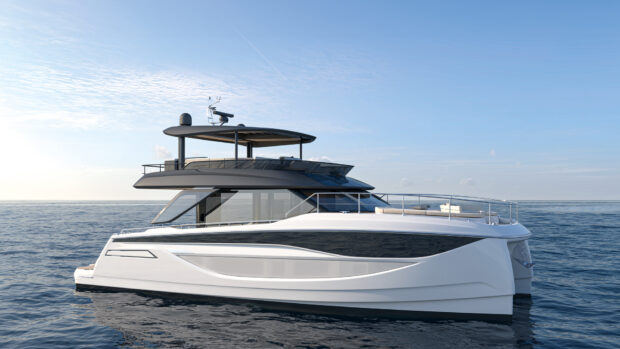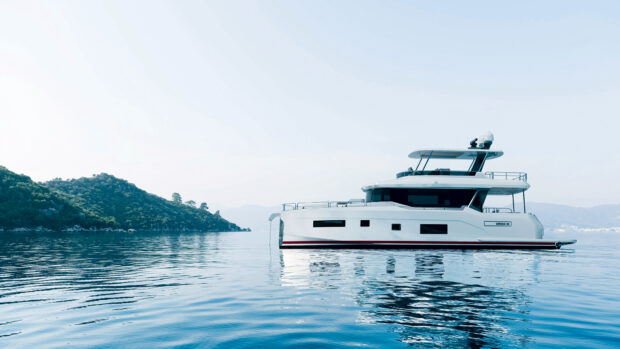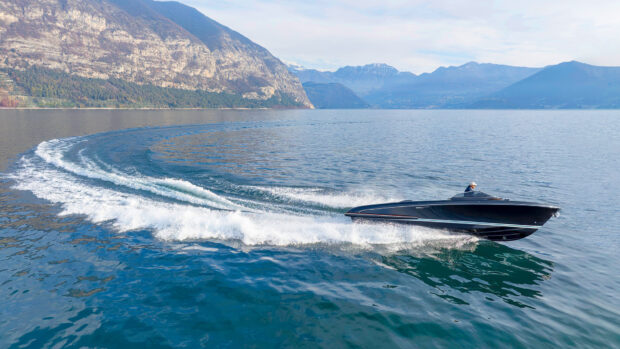This new series hybrid motor yacht claims to offer the refined cruising experience of an all-electric craft with the range and seakeeping of a diesel one. Hugo Andreae investigates
Turkish swift trawler builder Sirena Marine is developing what is likely to be the world’s first production motor yacht to use a series hybrid drivetrain.
Until now all the diesel electric craft we’ve seen from the likes of Greenline, Mochi and Hardy have used parallel hybrid drives. This means that both the diesel engine(s) and electric motor(s) can propel the craft directly, either independently or in tandem.
Sirena’s new series hybrid system relies purely on electric motors to propel the boat. The two diesel engines have no physical connection to the gearbox or shaft. Instead they are used solely to supply electricity to the motors and battery packs. This should give the craft many of the advantages of an electric boat, such as quieter running and lower emissions, without the disadvantages such as limited range.
So far the only manufacturers we know of taking this series hybrid approach are powercat builders Silent Yachts and Sunreef, who use diesel-powered generators as range extenders on their electric solar assisted catamarans, and the even more rarefied Enata Foiler sportsboat.
Article continues below…

Best hybrid diesel electric boats: The best of both worlds?

New Cauldwell outboard motor: Petrol performance & diesel reliability?
Electric drive
The model Sirena has chosen to show off this new technology is a much more conventional monohull trawler yacht design, in this case a coupé version of the 48 flybridge launched at Cannes last year.
In standard form this comfortable three- cabin, two-heads semi-displacement cruiser is powered by a pair of 550hp Cummins diesels on V-drive shafts, giving it a top speed of around 22 knots and a range of 250nm at 10 knots from its 1,900 litre fuel capacity.
The coupé version, as well as being slightly lower and lighter, also has a longer roofline on which to mount solar cells. While these will not generate enough solar energy to drive the boat directly, it will help top up the batteries and enable it to spend long hours at anchor in silent mode without running either of the generators.

Twin battery banks and variable speed generators provide the power
The main source of power will come instead from a combination of two 39.1kWh lithium ion battery packs and a pair of 180kW variable speed generators feeding twin 213kW electric motors. The entire drive system is supplied by Italian hybrid specialist E-Motion Marine.
This will give it a predicted top speed of 14 knots and a recommended cruising speed of 6.5 knots but an estimated range of 350nm when using both battery and diesel reserves. Sirena claims that over 90 days of mixed use, this could save 8,800 litres of fuel and 22 tonnes of CO2.
Less waste
While these figures look a little optimistic to our eyes (relying on some very heavy usage of the standard boat’s generators to bump up the daily fuel burn figures), there is some solid scientific reasoning behind them.

Electric drives should make for quieter cruising and lower fuel consumption
Most of the time, the big Cummins engines needed to deliver that 22-knot top speed are running well below their peak efficiency, meaning a sizeable percentage of the diesel’s latent energy is going to waste, largely as excess heat. They also take up a lot of space, add weight and generate considerable noise and vibration.
Having two much smaller engines that run at or close to peak efficiency not only means less fuel goes to waste but any excess electricity generated can be used to recharge the batteries. Being so much smaller they are also quieter, smoother and lighter. It’s not all one-way traffic though, as the batteries themselves more than offset any weight savings from the engines, and the raw materials needed to produce them come with their own environmental costs.

Big batteries will run the boat’s electrical systems for 8 hours at anchor
Arguably, just as important as the reduced carbon footprint are the more immediate and tangible benefits of a cleaner, quieter cruising experience. With the standard 78kWh battery pack, the hybrid Coupé will be able to cruise at 6.5 knots in full electric mode for 1hr 45mins, a distance of 12nm.
Upgrade to the optional 156kWh battery pack and that doubles to 3hr 35min and 24nm. Clearly, neither of these are particularly long distances but the ability to hop from bay to bay in near silence when exploring a local area then switch to generator mode for longer passages sounds very appealing.

One of the two 213kW electric motors that will propel the Coupé at all times
Silent nights
Those big batteries have another major benefit, the ability to power all the ship’s systems, including air-conditioning and electric stabilisers, without running a generator, making for quieter nights at anchor and no smelly diesel fumes.
The standard battery should last for up to 8 hours at anchor, while the optional one doubles this to 16 hours. The real clincher is that the standard battery can also be recharged to 90% capacity in as little as 45 minutes, either by running the generators at maximum speed or from a shorepower connection.
Speaking exclusively to MBY at the Düsseldorf boat show, Sirena’s CEO Çağin Genç confirmed that he was committed to building the first hybrid Coupé as a test bed this summer, and running it extensively to ensure it all works reliably before offering it as a factory fit option to customers.
He wouldn’t be drawn on pricing, admitting only that it would be considerably more expensive than the standard diesel model, but if it offers a quieter, more refined cruising experience to customers while simultaneously reducing their carbon footprint, it could well be a price worth paying.










